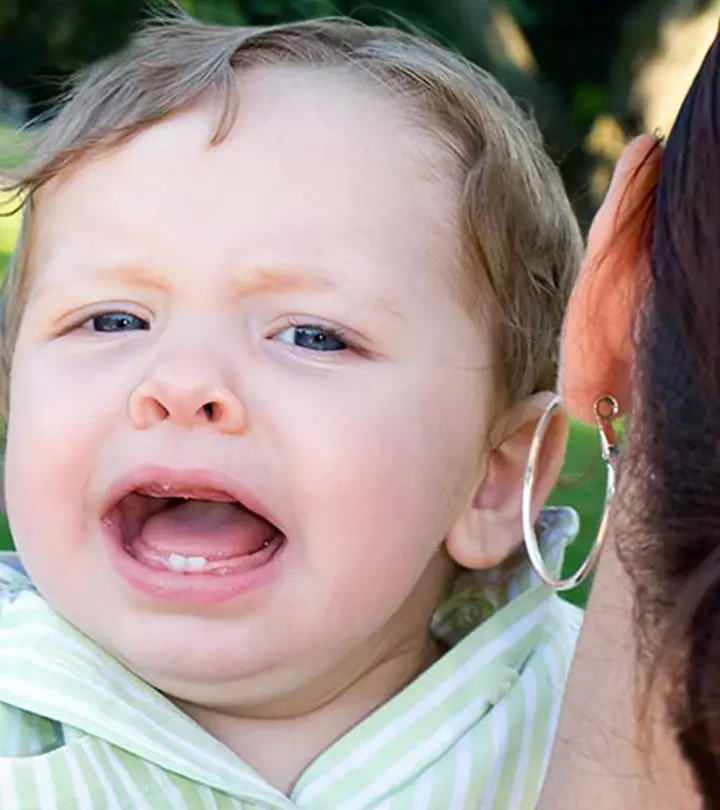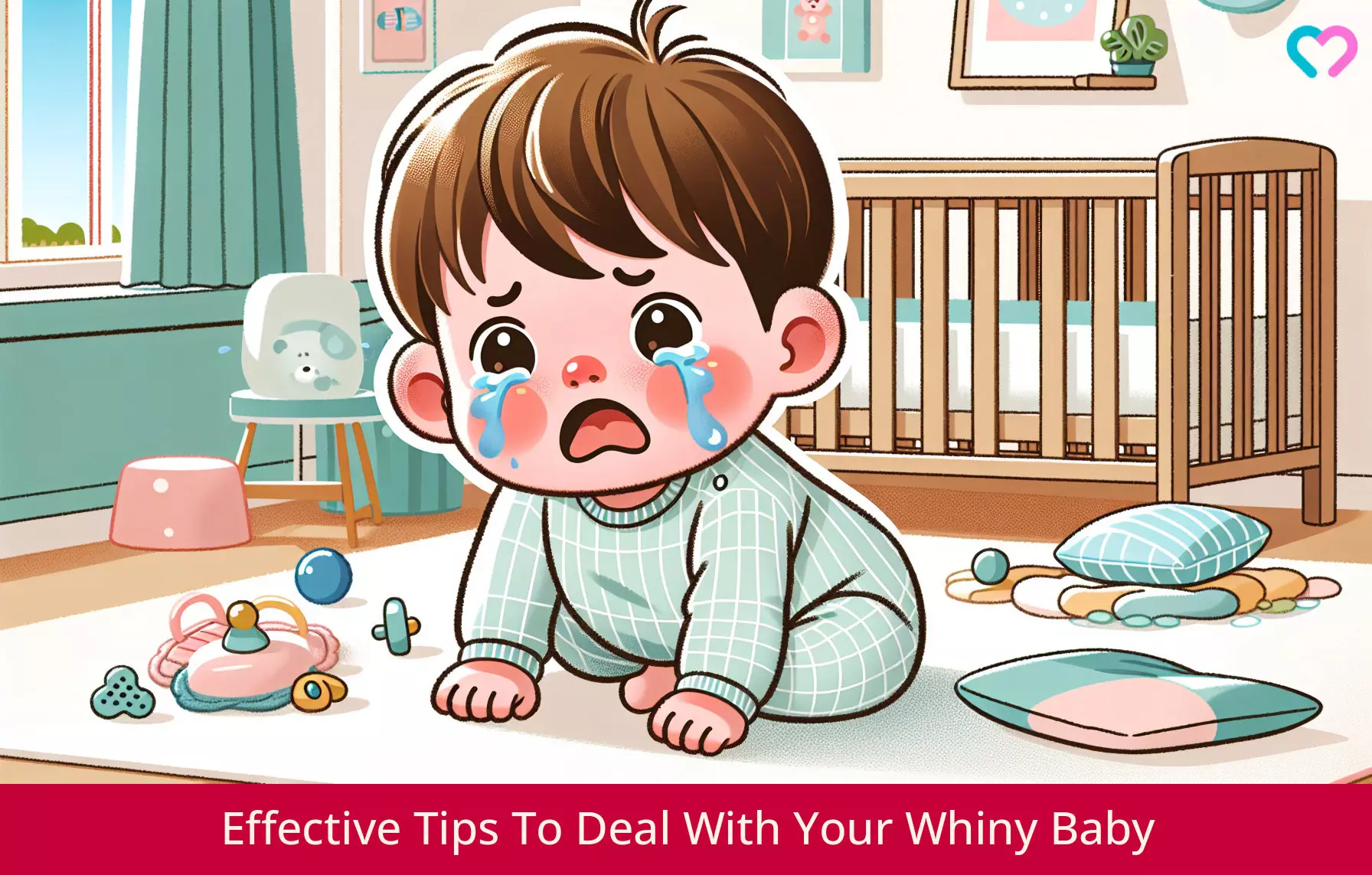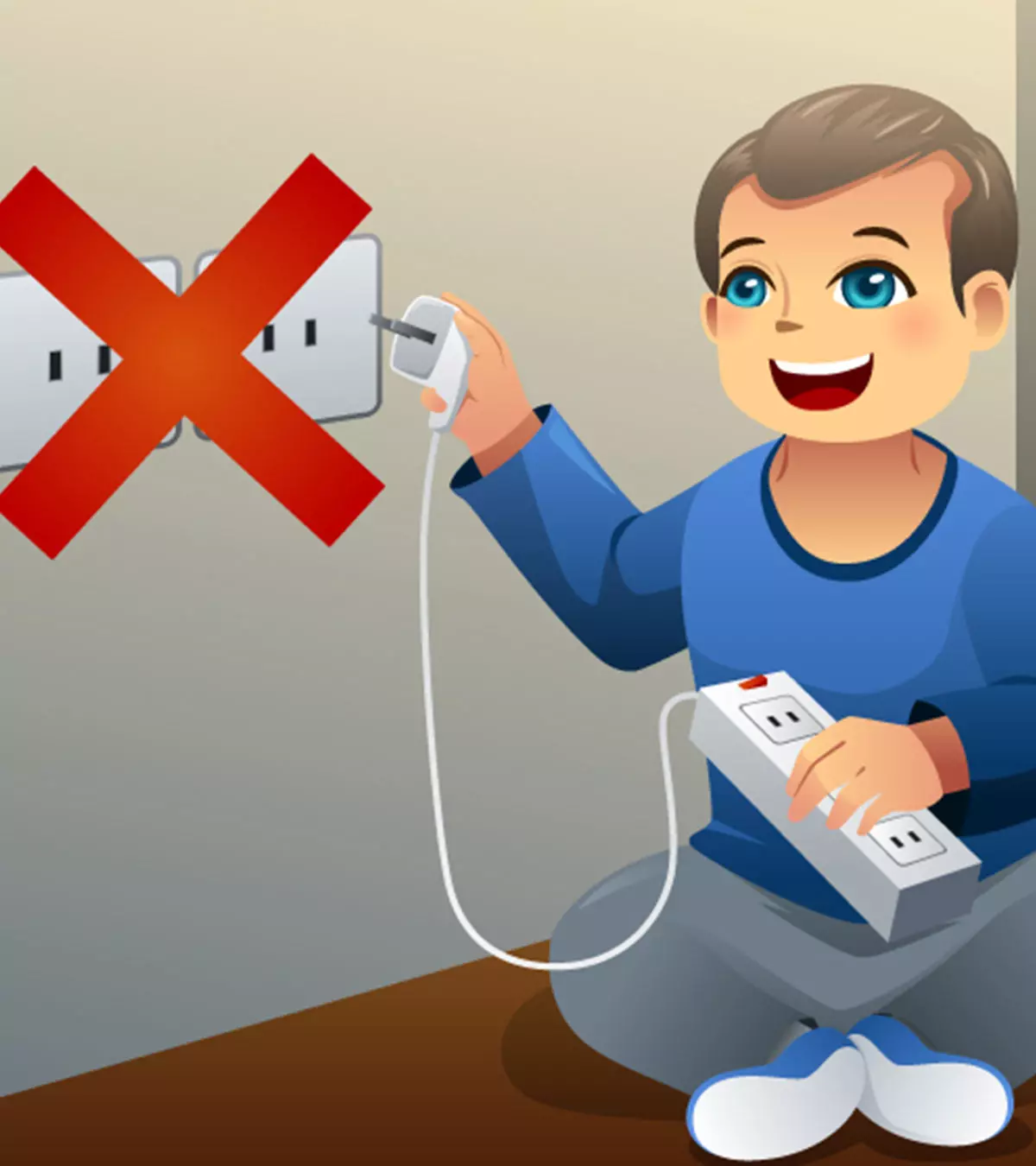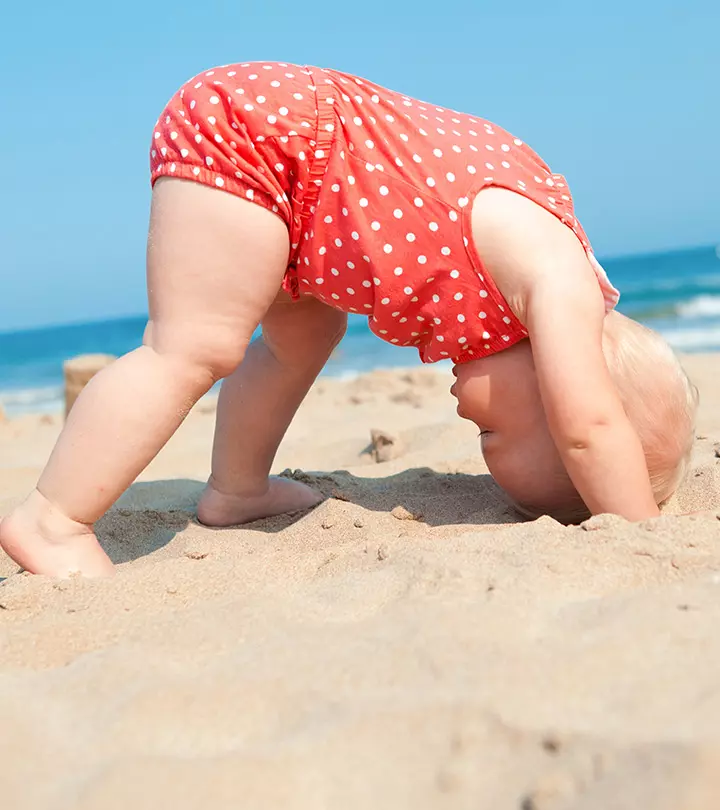
Image: ShutterStock
Babies cannot communicate in the way other people do, at least until about three years. So if you have a whiny baby, do not always consider it a tantrum. Instead, babies use whining as a form of communication to tell or express other people about their discomfort or frustration. But whining often might put the parents’ patience to the test. So what do you do in such situations to manage your baby? Read on to know about why a baby is whining and ways to manage it.

Key Pointers
- Generally, the causes of a baby’s whining include hunger, tiredness, sleepiness, stomach discomfort, pain, or boredom.
- It is vital to respond kindly to the baby’s needs.
- Breastfeeding, rocking, massaging, changing the diaper, or swaddling the baby may soothe them.
- Teaching them basic communication methods, setting boundaries, eliminating irritants, or distracting the child could help.
- However, if the baby cries for long periods, it is crucial to contact a pediatrician to rule out issues.
What Is Whining In Babies?
Whining in babies can be explained as a form of frustration due to their inability to perform an action or an unexpected outcome of a performed action. A baby may start whining as a response to something or to express feelings such as hunger, pain, and tiredness. Babies usually start whining in the fourth month of their life, or a couple of months after that (1).
Whining, thus, is a cry for communication. But what are the various messages that a baby can convey by whining?
Why Do Babies Whine?
The reasons for whining can range from boredom or frustration in general to a probable manifestation of a health ailment. Let’s see them all.
1. Cannot communicate beyond a limited point
Your baby will babble for the first time after the completion of four months. You will notice that they babble differently in different situations. Despite that, their range of effective communication is limited, and the baby cannot share complex emotions through basic sounds. As a result, most babies may resort to whining. In other words, whining is the best way for babies who cannot yet talk, to get their feelings across quickly (11).
2. Communicate about hunger
Babies have limited vocabulary and minimal speech capabilities. The best way they can share their thoughts is through whining and crying. If your baby cries and whines, it is quite likely that the baby is asking you for a feed (12).
3. Tired
Your little one requires a lot of rest and sleep, and any exerting activity such as a long car journey can tire them out quickly. If your baby whines after staying awake for long hours, it means they are tired, possibly due to sensory overload, and want to slumber. Usually, whining in such cases will be accompanied by generally being irritable, having a bad temperament, and being disinterested in interacting with others (11).
Suggesting a remedy for fatigue, pediatrician Noah Schwartz says, “Sleep training helps teach your baby to self-soothe and put themselves to sleep. It includes several different techniques, including the ‘cry it out’ approach or the preferred ‘check and console’ method. The result is a step toward independence for your baby and more sleep for you (13).”
4. Needs a diaper change
The next time your baby whines, check the diaper immediately. Chances are they just defecated or urinated and need a diaper change. Whining is just their way of telling you that – to change a soggy diaper and relieve them of the discomfort which may lead to diaper rash if not addressed properly (13).
3. Feeling hot or cold
You put your baby in a warm bath on a cold morning, and the baby suddenly begins to whine. That is, most probably, their way of telling that the water is not quite warm. Babies are sensitive to temperature fluctuations and could whine when they do not find it suitable to their liking. This may even happen when you move your baby to a new place, where the temperature is too hot or too cold for the baby (13).
6. Could be fever, rash or pain
Your baby could just be feeling uneasy due to a fever and is communicating it through whining. So, check if the baby has a fever, an insect bite, or itchy rash that is causing them irritation. As babies get older, they become mobile and crawl, which can cause them bruises here and there. Whining is a way of expressing pain if they get bruised or injured. Check for any scratches or bruises on the little one’s body if they whine (14).
7. That naughty air bubble in the windpipe
If the baby cries after feeding or starts whining for no apparent reason, it could be an air bubble stuck in their throat that is causing the discomfort. A gentle pat on the back should be able to release it through a burp (13).
8. They need some pampering
Your baby could whine for you to hold and cuddle them. It could be one way of them asking you to “stay close” or “hold me tight”. It is just their desire to have a sense of security and attention that may make them whine but positively. Research suggests that babies may cry or whine to attain the complete attention of their parents, which can result in a healthy upbringing since the parent is always around to protect and feed the little one (2) (12).
Sharing his observations, Daniel Osorio, a father and blogger, writes, “I have learned that I need to be aware of my daughter’s feelings and try to understand what she wants. If all her basic needs have been met, yet she cries, there is a chance she may need a good cry to release stress. Then, I am more than happy to provide her with the appropriate environment for her to let it all out (i).”
9. Overtired and refuses to sleep
An overtired baby may be reluctant to sleep. In such cases, avoid eye contact with them as your gestures also might be tiresome for the baby. Take the baby to a dark and quiet room and cajole them into sleeping (11).
Whining is not always a positive sign. Sometimes, it could be the result of some health condition, which your baby is unable to communicate.
Critical Reasons
10. Language issues due to autism
Babies born with autism have impaired language development (3). This means the baby is less likely to pick up new words and more likely to have a deficiency in verbal communication. A baby with autism may whine due to the frustration caused by the inability to communicate any thoughts. This is more likely to happen when you say or do something that the baby is unable to comprehend and has difficulty reacting to.
Some babies with autism may have trouble digesting amino acids in the protein gluten, which is found in grains such as wheat, barley, rye, and oats (4). These foods are quite commonly given to weaning babies. The unbroken amino acid chains, called peptides, breach the intestinal wall and reach the brain through the bloodstream. When this happens, the body’s immune system gets alerted and mounts an allergic reaction that may result in a stomachache and neurological symptoms such as hyperactivity, aggression, and chronic whining.
11. Gastrointestinal reflux

Babies tend to develop gastrointestinal or acid reflux due to an underdeveloped lower esophageal sphincter, which is a bundle of muscles present at the point where the esophagus meets the stomach. Its primary function is to prevent the backflow of stomach contents into the esophagus. In babies, a poorly developed sphincter releases some stomach acid to the esophagus, causing pain, gas, and irritation. Being fussy, crying, or whining is one of the symptoms of this condition (5).
In such cases, your baby may whine a few minutes after feeding or during the feeding. A collaborative study conducted by multiple institutions found that over 25% of infants aged 0-18 months experience daily symptoms of GERD. However, the review also indicated that these symptoms typically resolve completely by the time the infants turn 12 months.
How To Deal With A Whiny Baby?
A whiny baby can test your patience, especially when you do not see a reason for it. The following tips should help you the next time your little one whines (11) (12) (13) (15).
1. Stay calm, be patient
If your baby whines, then it is for a reason. Do not let the whining annoy or anger you, no matter how difficult it gets. You are the only one who can understand your baby’s whining. Also, you will not become a bad parent just because your baby whines frequently. Therefore, take deep breaths, stay calm, and be patient. If the situation is exhausting you, take a break. Give the baby to your partner or any other caretaker, go for a walk, and come back. Even a 10-minute break would bring back your sanity.
Daniel adds, “While she cries… She shows her strength and frustrations with her wild movements and twitches, she shakes her head to both sides, and most of the time cries on my shoulder. Sometimes it feels like she wants to get inside of me by pushing her head through my shoulder.
“I, on the other hand, am calm, stand still, and not doing anything to try to soothe her. I do not rock her, sing to her, talk to her, shake her, or move in synchronized ways to try to calm her down. Instead, I remain calm throughout the whole process and show her my support by holding her. Eventually, she calms down a bit and breathes heavily, almost like sighing.”
2. Breastfeed for relief
Breastfeeding not just provides the much-needed nourishment to your baby but is also a time of bonding between the mother and baby. The next time your baby whines, just hold them in your arms and feed. Skin-to-skin contact and your heartbeat can calm your baby’s whining.
3. Teach your baby basic yet useful communication
You can make your baby learn simple sounds or expressions to convey specific emotions. For example, when the baby whines, you can show the milk bottle and ask, “Are you hungry?”. If the baby stops crying and reaches out for the bottle, then you just fixed your baby’s whining!
As the baby goes through developmental changes, the baby will eventually connect hunger with the bottle and understand that the solution to their hunger is the bottle. You can teach your baby about such object-cause-effect relationships through simple words and sign language.
Either way, asking questions, using verbal cues and basic signs and sounds are great ways to make your little one communicate.
4. Eliminate the probable sources of whining
Does your baby always whine if a sibling or playmate takes their toys away? If yes, sort the matter by getting your elder child a new toy. Does your baby whine when being held by a certain family member? Let that member keep away from the baby. Check for such inconspicuous stimuli for your baby’s whining and eliminate them to mitigate whining.
5. Rock your baby

It is a time-tested trick that works so well that experts recommend it for crying and whining babies (6). Hold the baby on your shoulder, and rock them back and forth. You can also hold your baby in your arms and sit on a rocking chair or put them in a rocking cradle to subdue the whining.
6. Play some sounds
Sounds from the baby’s toys or music can help distract the baby and stop their whining. The next time your little one whines, play some peppy and catchy music that will divert their attention.
7. Swaddle the baby
Swaddle your baby by wrapping them in a soft blanket with the head out of the wrap. This is one of the best calming techniques for a baby, especially when the probable cause is fluctuations in the temperature. A stable, comfortable room temperature will help your baby relax.
 Did you know?
Did you know?8. Change clothes and diaper
Always dress your baby in clothes that are appropriate for the weather. Also, change the diaper at regular time intervals even if the baby has not soiled it. Diapers have an external plastic lining that restricts air circulation that can cause discomfort to the baby, making them whine.
9. Give them a relaxing massage

A gentle massage is a wonderful way to deal with a baby’s whining. Place your baby on the back and gently massage the tummy in circular motions. You can also place them on the tummy and massage the back, arms, and legs. The parent’s soothing touch could calm a whiny baby.
10. Give a hot water bath
Warm water soothes adults and babies alike. Give your whining little one a warm bath. Dress them and then swaddle them in a warm blanket. You can follow this with a feeding session to calm your baby completely. Be cautious, though, since some babies dislike water and whine the most when they come in contact with water.
11. Pat the back
Hold your baby on your shoulders and gently pat between the shoulder blades. This should release the trapped air bubble and stop them from whining.
12. Use a pacifier
A pacifier works in soothing a shiny baby, especially when the baby is bottle-fed. Babies can steady their heart rate and calm themselves down when they are sucking at something. It is a convenient way to deal with your whining baby.
13. Go for a walk
Perhaps your baby is just bored and needs a change in the surroundings. Put your baby in a stroller and take them out for a walk. Show interesting sights and objects, and they could get distracted and amused, and stop whining.
What If Nothing Works?
You may have tried all possible tricks, but nothing seems to work. Here are some tips for dealing with a whiny baby in such a situation:
1. Do not get frustrated

You must keep yourself cool even if your baby doesn’t seem to stop whining. If it is too much for you to handle, then request your partner to look after the baby for a few hours while you go out to get some fresh air. Do not hesitate to ask for help. Give a call to your mom, sister, or a reliable friend and ask them to stay with you for a few days. It will give you the needed emotional and psychological strength to deal with the stress caused by a whining baby.
2. Check with the pediatrician
As mentioned above, there can be some serious connotations for a baby’s whining. If you feel something is abnormal about your baby’s whining, then talk to a pediatrician soon. A medical practitioner will be able to see beyond the usual whining to detect an acute underlying cause to it.
In case your baby has a more serious cause for whining, do not slip into a panic state. Keep your nerves calm. Discuss the matter thoroughly with your pediatrician and take a second opinion if you think it necessary.
 Quick tip
Quick tipFrequently Asked Questions
1. Do babies whine for no reason?
Yes, babies sometimes may whine for no reason or just because they are bored. Engaging them if they are bored can help stop whining. Try to understand the cause of their whining to it.
2. Is whining a learned behavior?
Yes, whining is a learned behavior. Children expect a response from parents or caretakers. It is their way of seeking attention, and it does not matter whether the response is positive or negative. Once they learn that they may get your attention by whining, they continue doing so (7).
3. At what age do babies stop whining?
Whining is common till the age of four. However, it may continue longer for children who do not learn to convey their emotions through words in time (8).
4. At what age do babies whine the most?
Babies whine the most between two weeks and four months of age. It is how they express annoyance over things. Pain, sickness, overstimulation, or sleep troubles causes babies to whine excessively. Some babies have long-lasting crying a few weeks after birth, known as colic. But it subsides when the baby turns three or four months old (7).
5. Is whining a developmental behavior?
Whining may be a request for comfort, help, or a connection with the caregiver. When children whine, they are communicating valuable information. So, it is a developmentally appropriate element of childhood. The parent’s responsibility is not to ignore whining but to try to understand its root cause (7).
6. Is it normal for my baby to whine a lot?
It is normal for babies to whine for around one to three hours daily. This is because babies cannot communicate feelings of being hungry, tired, and sick, unlike grown-up kids. However, if your baby is frequently crying, it is a good idea to consult a doctor to rule out health issues (9).
Whining in babies is a way of communicating boredom, frustration, hunger, pain, discomfort, tiredness, or the need for attention as they cannot speak what they feel. It is best to attend to your little one during the episodes of whining promptly as it may indicate illness or disorder in some cases. Try calming them with a pacifier, soothing music, breastfeeding, or a diaper change. Have patience or ask your partner or a relative to help you with the baby. Check with a pediatrician if your whiny baby does not respond to your attempts to comfort them.
Infographic: How To Deal With A Whiny Baby?
Whining is an expected behavior among babies, and it can be challenging for parents to figure out ways to stop it. To help you with that, the infographic below presents measures to help your baby stop whining. Scroll down to learn more about this!
Some thing wrong with infographic shortcode. please verify shortcode syntax
Illustration: Effective Tips To Deal With Your Whiny Baby

Image: Dall·E/MomJunction Design Team
Dealing with a whiny baby can be frustrating. Learn 8 reasons why your baby is whiny and solutions to help them stop!
Personal Experience: Source
MomJunction articles include first-hand experiences to provide you with better insights through real-life narratives. Here are the sources of personal accounts referenced in this article.
i. What my baby taught me about crying.https://medium.com/siena-journey/what-my-baby-taught-me-about-crying-65337ea756f3
References
1. Important Milestones: Your Baby By Four Months; Center For Disease Control And Prevention (2019)
2. Joanna Dudek et al.; Infant Cries Rattle Adult Cognition; National Center For Biotechnology Information (2016)
3. What Are the Symptoms of Autism?; Autism Speaks
4. Nebraska Autism Parent Booklet
5. What is baby reflux? Symptoms and support; NCT
6. Colic Relief Tips for Parents; American Academy of Pediatrics
7. WHY DO CHILDREN WHINE? 5 WAYS TO RESPOND TO WHINING; RELAVATE COUNSELING
8. Colic; Kidshealth.org
9. Excessive crying in infants; Medlineplus.gov
10. Babywearing; La Leche League International
11. How to Cope (and Help!) When Your Child Whines; ZERO TO THREE
12. Why Do Children Whine? 5 Ways to Respond to Whining; Relavate Counseling
13. Why Is Your Baby Crying?; Cleveland Clinic
14. Crying Child – 3 Months and Older; Seattle Children’s Hospital
15. How to Stop Your Child’s Whining; Nationwide Children’s Hospital
Community Experiences
Join the conversation and become a part of our nurturing community! Share your stories, experiences, and insights to connect with fellow parents.
Read full bio of Michelle Bowyer
Read full bio of Rohit Garoo
Read full bio of Dr. Ritika Shah
Read full bio of Anindita Ghatak
















